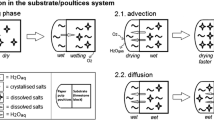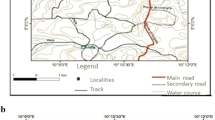Abstract
The extraction of salts by layered (bentonite) and fibrous (sepiolite) clay poultices from stone materials currently used in Heritage buildings was studied. Analyses were performed on stones affected by salts but not submitted to humidity, and also on stones affected by salts and simultaneously submitted to continuous or intermittent humidity during the salt-extraction process. From the experimental results and the statistical analysis, the application of two successive poultices is sufficient for an efficient extraction of Cl− and NO −3 in the absence of humidity. However, under humid conditions, the efficiency of the method is reduced considerably. For SO 2−4 , the use of hydrotalcites (anionic clays) is recommended for more effective extraction.
Similar content being viewed by others
References
Arnold, A. (1996) Alteration et conservation d’oeuvres culturelles en matériaux poreux affectés par des sels. Pp. 1–20 in: Le dessalement des matériaux poreux. Darantier, France.
Bromblet, P. and Verges-Belmin, V. (1996) L’élimination des sulfates sur la statuaire calcaire de plein air: un habitude discutable. Pp. 55–64 in: Le dessalement des matériaux poreux. Darantiere, France.
Evans, I.S. (1970) Salt crystallisation and rock weathering: A review. Revue Géomorphologie Dynamique, 19, 153–177.
Gabriel, K.R. (1971) The biplot-graphic display of matrices with applications to principal component analysis. Biome-trika, 58, 453–467.
Gabriel, K.R. (1972) Analysis of meteorological data by means of canonical decomposition and biplots. Journal of Applied Meteorology, 11, 1071–1077.
Gabriel K.R. (1995) MANOVA biplots for two-way contingency tables. Pp. 227–268 in: Recent Advances in Descriptive Multivariate Analysis (W. Krzanowsky, editor). Clarendon Press, Oxford, England.
Galindo, M.P. (1986) Una alternativa de representacion simultanea: HJ-Biplot. Qüestiio, 1, 13–23.
Garcia-Talegón, J., Ifligo, A.C., Vicente, M.A., Vargas, M., Pérez-Rodriguez, J.L. and Molina, E. (1994) Granites employed in Avila (Spain). I: Chemical composition of the différents types. Materiales de Construcciôn, 44, 23–28.
Garci’a-Talegón, J., Vicente, M.A. and Molina, E. (1999) Decay of granite monuments due to salt crystallization in a non-polluted urban environment. Materiales de Construcciôn, 49, 17–27.
Gower, J.C. and Hand, D.J. (1996) Biplots. Chapman & Hall, London, 277 pp.
Inigo, A.C., Garcia-Talegón, J., Vicente, M.A., Vargas, M., Pérez-Rodrfguez, J.L. and Molina, E. (1994) Granites employed in Avila (Spain). II: Petrophysical characteristics. Materielles de Construction, 44, 28–37.
Ling, D. and Smith, S. (1996) To desalinate or not to desalinate? That is the question. Pp. 65–74 in: Le Dessalement des Matériaux Poreux. Darantiere France.
NORMAL (1983) Dosaggio dei sali solubil. M. Nimmo-ICR, Roma 13/83, Italy.
Simon, S., Herrn, C., Porst, A. and Pursche, J. (1996) Desalination and control of salt transport phenomena experiences with compress renderings in the ring crypt of St. Emmeram, Regensburg. Pp. 147–159 in: Le Dessalement des Matériaux Poreux. Darantiere France.
Trujillano, R., Vicente, M.A. and Rives, V. (1998) Utilization de arcillas catiónicas y aniónicas en la limpieza y desalado del Patrimonio Histórico. Pp. 192–194 in: Congreso International de rehabilitation del Patrimonio Histórico, Libro de Actas, La Habana, Cuba.
Vicente, M.A. (1994) Granitic materials and historical monuments: Study of the factors and mechanisms of weathering and application to historical heritage conservation. Pp. 4–45 in: Degradation and Conservation of Granitic Rocks in Monuments. (M.A. Vicente, J. Delgado-Rodrigues and J. Acevedo, editors). D.G.XII Science, Research and Development, Brussels.
Vicente, M.A. (1996) The role of salt crystallization in the degradation processes of granite monuments. Pp. 147–155 in: Origin, Mechanisms and Effects of Salts on Degradation of Monuments in Marine and Continental Environments (F. Zezza, editor). Tecnomack, Bari, Italy.
Vicente-Villardon, J.L. (1992) Una alternativa a los métodos factoriales clâsicos basada en una generalization de los métodos biplot. Ph.D. thesis, Univ. Salamanca, Salamanca, Spain, 248 pp.
Weber, J., Leitner, H., Gaggi, W. and Szambelan, R. (1996) Crystallization of sulphate salts induced by selective salt extraction by poultices: Results from a case study. Pp. 167–181 in: Origin, Mechanisms and Effects of Salts on Degradation of Monuments in Marine and Continental Environments (F. Zezza, editor). Tecnomack, Bari, Italy.
Author information
Authors and Affiliations
Corresponding author
Rights and permissions
About this article
Cite this article
Vicente, M.A., Vicente-Tavera, S. Clay Poultices in Salt Extraction from Ornamental Stones: A Statistical Approach. Clays Clay Miner. 49, 227–235 (2001). https://doi.org/10.1346/CCMN.2001.0490305
Received:
Revised:
Published:
Issue Date:
DOI: https://doi.org/10.1346/CCMN.2001.0490305




